The jambalaya recipe came from an old Boy Scout cookbook. Pour a can of condensed onion soup, beef stock, and tomato sauce, along with two cans of water, into a Dutch oven. Add two cups of rice, smoked sausage, shrimp, diced bell pepper and green onions, plus garlic, herbs and spices. Cover the lid with charcoal briquettes. In 90 minutes, it’s done. Easy, right?
If only those trout would have stopped rising.
On the penultimate day of a four-day camping trip on the Upper Delaware River, I stood calf-deep contemplating the existential question of whether to cook or not to cook. From upstream, an unending conveyor belt of sulfurs and March browns drifted past, pinwheeling in eddies and gathering in backwaters. A cold drizzle had trapped them on the surface like a wet blanket, preventing any from taking flight. Dozens of wild browns and rainbows had lined up across a broad flat, gulping and slashing at the helpless bugs.
Meanwhile, half a mile downriver, tucked beneath a camouflage tarp rigged to a large river birch, a group of non-fishing friends lounged comfortably around a campfire. When I left them earlier, I mentioned that I would serve a meal that evening. They nodded and wished me luck. Dinners on this annual trip have always been a bit of a free-for-all. There are no planned mealtimes or designated seatings; you throw down when there is space on the campfire. Over the last few days, we enjoyed everything from authentic Kung Pao chicken to steak kabobs to batter-dipped soft-shelled crabs. Now it was my turn.
But those trout kept rising.
More Like This
I don’t remember it ever being so easy on the normally technical and unforgiving Delaware. On this magical day, any reasonable reach-cast with a CDC sulfur resulted in an eat or at least a swing and a miss. An hour in, I already landed half a dozen and dropped a few others – all thick rainbows up to 18 inches or thereabouts. When I switched to an oversized March Brown stacked high with deer hair, the fish seemed to grow larger and their rises more emphatic. Another thirty minutes later, I had released two browns pushing 21 inches and missed a few others that looked almost as broad as salmon.
I glanced at my watch. Five-fifteen. If I left now, by the time I got the charcoal ready and added all the ingredients to the Dutch oven, I could serve dinner by 7:30. I looked back at the river. Trout still actively gorged, some throwing wide arcs of water in their enthusiasm.
Should I keep casting, or should I go?
There was a time not long ago when my decision would have been too easy: dinner would be late. Really late. Sorry guys, the trout wouldn’t let me leave.

But then a couple of years ago, I wrote an essay about “slow fishing,” which called on anglers to evolve beyond the predatory need to catch every fish in the river. Today’s modern anglers, I noted, are the best-equipped, most knowledgeable in the history of the sport. Yet racking up big numbers, just because you can, is ultimately a soulless, empty endeavor. The idea of throttling back to purposefully catch fewer fish should be the next evolution of catch and release, I argued.
And now, literally in front of me, was an opportunity to practice true slow fishing. The Delaware continued to pour its heart out, pumping out rafts of mayflies on a damp May afternoon. Large, wild fish rose to eat them, some just a short cast away. I took a deep breath. Then I turned my back on the bugs and trout, and I walked away.
Back at camp, I shed my waders, leaned my rod against a tree, and began slicing, chopping, and pouring ingredients. At the campfire, charcoal burned down and whitened. I placed the Dutch Oven on some coals and piled more on the lid. Then I opened a beer and sat with my friends and told them about the fishing action. Forty-five minutes later, I lifted the lid, stirred once, then substituted old coals for new. An hour and ten minutes in, you could begin to smell it.
That’s when I happened to glance downriver.
Fifty yards from camp, a single trout tilted up a few feet off the bank. A few seconds later, it came up a second time. The fish held in a beautiful lie, the kind where you could approach from upriver, drop some slack in your line and leader, and let the current take the fly into its feeding lane.

By now, I could really smell the jambalaya, the marriage of herbs, shrimp, and sausage escaping from the oven in delightful puffs of steam. It would be ready in minutes.
I casually wandered over to the tree and reached for my fly rod. Sans waders, I approached the still rising trout. After a few errant casts, the fly touched down a yard above the last rise. The trout glided upward and ate. I set, and after a two-minute fight, slid a 14-inch wild brown into the shallows that I promptly released.
Did I really need to catch that last trout? Wouldn’t a true practitioner of slow fishing have been content to just watch it rise?
Great questions to ponder over dinner, because it was time to eat.






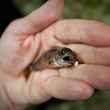
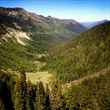
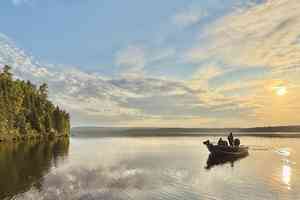
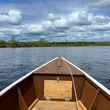
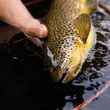



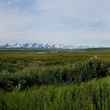



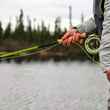



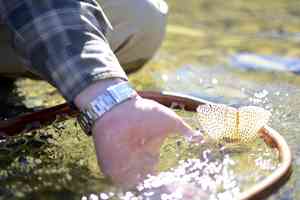
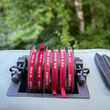
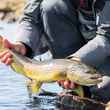
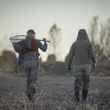
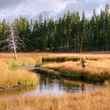
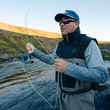

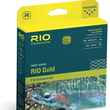
Comments
Paul Quinnett replied on Permalink
I am now eighty five and have been fly fishing since I was twelve. My slow fishing days are over now, as are my wading days. Too frail to risk breaking the tippet. Now I sit and watch and share the beauty with the younger ones. Celebrate the slow down.. it is coming for us one and all. Wonderful story.
Pages